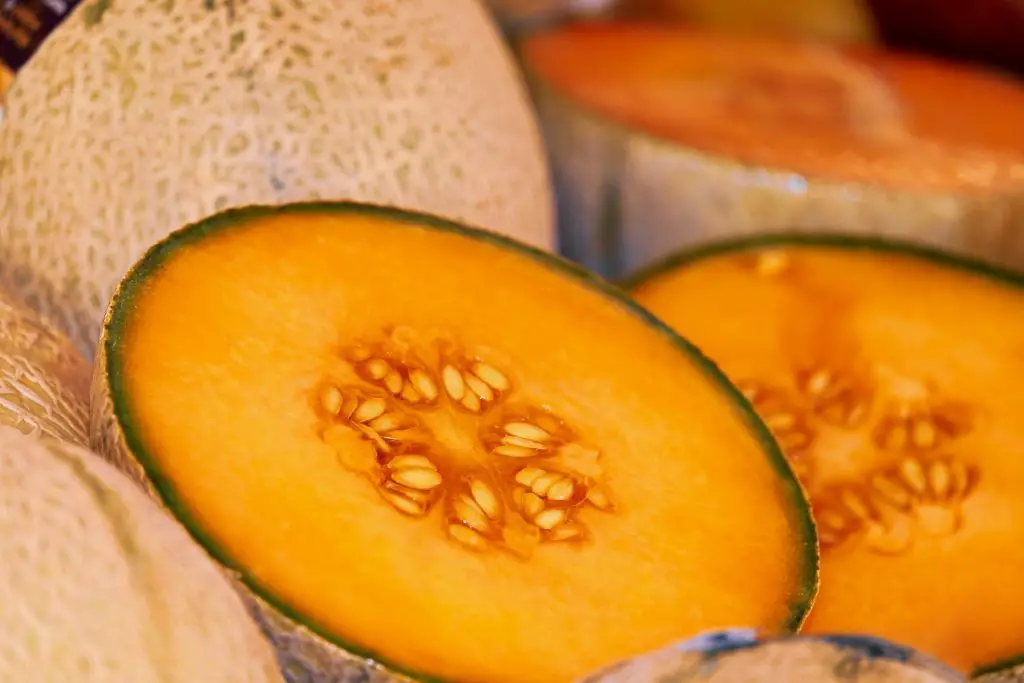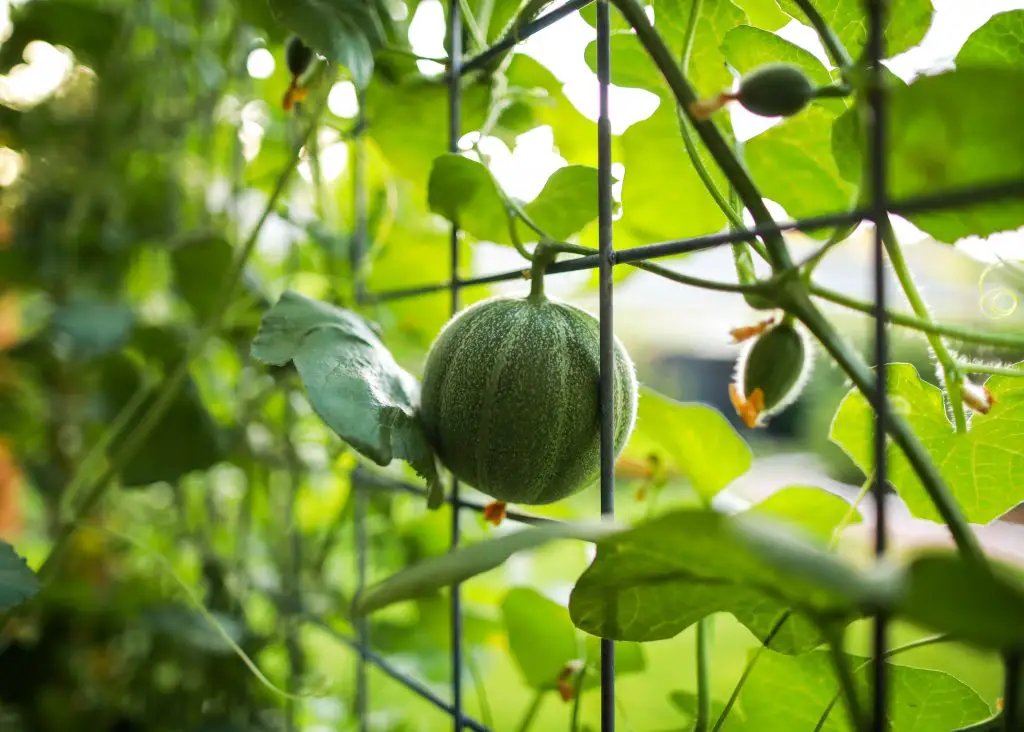How Many Cantaloupes Per Plant? Cantaloupes are one of the most popular fruits to eat, particularly in Summer when it’s hot. However, Cantaloupe (sometimes referred to as Rockmelon) that appears in most supermarkets is not actually a Cantaloupe, it is a Muskmelon. The net-like pattern on the surface of “Cantaloupe” is actually the defining feature of a Muskmelon.
The skin of a true Cantaloupe is smooth and much harder than the Muskmelon and it is generally more difficult to grow, which is why it is not commercially grown in the United States. For the purpose of the rest of the article, I will refer to the melons as Cantaloupe because the misconception is so engrained that any reference to Muskmelon just causes confusion.
A Cantaloupe plant will on average produce 2 fruit per plant according to the study by Purdue University which looked at 20 different varieties. The typical size per fruit is 4 to 5 lbs (approximately 2 kg) meaning that a yield of around 10 lbs (4.5 kg) per plant can be expected approximately 80 to 120 days after the seed has been planted.

Of the varieties tested in the study, the variety “Avatar” produced the highest yield largely because it produces exceptionally large fruits. However, the variety I would recommend based on the result of the study is “Home Run”. The reason for this is that it produced the earliest harvest of any the varieties tested and the highest average number of fruits.
For the home gardener, it is far better to have more fruits of a smaller size rather than having one or two large ones as the melons do not keep as well once they are cut.
Other varieties that produced a relatively early harvest are Aphrodite and Atlantis. The overall yield for all the varieties that are commercial available are provided in the table below.
| Variety | Fruit Per Plant | Weight per Fruit (lbs) | Yield (lbs) |
| Avatar | 1.7 | 8.2 | 14.1 |
| Strike | 2.3 | 5.2 | 12.0 |
| Grand Slam | 2.0 | 5.8 | 11.7 |
| Home Run | 2.5 | 4.5 | 11.1 |
| Atlantis | 1.8 | 6.1 | 11.0 |
| Origami | 1.7 | 6.4 | 10.8 |
| Aphrodite | 1.9 | 5.6 | 10.7 |
| Samoa | 1.9 | 4.7 | 8.9 |
| Athena | 2.0 | 4.3 | 8.8 |
| Majus | 1.7 | 4.7 | 8.0 |
| Tirreno | 1.9 | 3.6 | 7.0 |
How To Grow Cantaloupes
Cantaloupes are a member of the Cucurbit family which includes Pumpkin, Zucchini, Corn, and Watermelon. They are a frost-tender plant that requires warm conditions to thrive. In regions with cooler summers such as the UK or Ireland, it can be a real struggle to get a reasonable crop unless the melons are grown in the hoop house.
Plants can be established by direct sowing into the soil or into seed trays. However, due to the warm conditions required to germinate the seeds, a temperature of at least 59°F (15°C), it is best to grow them undercover. If you live in a region with particularly cold winters or you want to start the plants off early it best to used a heated propagation tray.
The heated propagation trays provide the ideal growing conditions for germinating seedlings and they are not overly expensive to purchase. The one we recommend is the iPower Heating Seed Starter Germination Kit, shown in the picture below largely because it has a vented humidity dome and is relatively inexpensive. Click on the link to see the current price on Amazon.

When planting the seeds sow them at a depth of 0.5 inches (1 to 2 cm) with 2 seeds per cell. This ensures that there is at least one seedling per cell. If both seeds germinate remove the weakest seedling after a couple of weeks. When deciding on the number of seeds to sow it is advisable to plant 25 to 50% more seeds than you think you need just in case any are destroyed when they are planted out in the garden.
If you need to purchase seeds and live in the US try Seed For Generations or St Clare Seeds. Both companies specialize in heirloom seed varieties and stock a wide range of Melon seeds. The advantage of purchasing heirloom seeds is that the seeds can be collected the following year so you only need to purchase them once. If you live in the UK I would suggest visiting Thompson & Morgan, this website has an extremely broad range of seeds but does sell hybrids as well as heirloom seeds.

Seedlings will take around 6 weeks to develop in size sufficiently to allow the seedling to be planted out into the garden. The plants should be spaced 2 to 3 ft apart but only when the temperatures are above 68°F (20°C). However, the seedlings can be planted out a little earlier if protection is provided. This can be done with either a Cloche or row cover as they will typically raise the temperature by a few degrees.
A Cloche can be made using a 2 or 3 Litre plastic milk carton by removing the base of the carton with a knife. When placing the container over the plant ensure that the lid is removed to allow the plant to be ventilated. Alternatively, you can purchase cloches on Amazon as they look a little nicer than milk cartons.
However, if you live in a cooler region it is worth purchasing a row cover instead because it will cover a larger area and will also be suitable for protecting the plant at the end of the season when it is relatively large. The product we recommend is the Growsun Garden Tunnel Plant Cover because it is relatively tall and has hoops that can be anchored deeply into the ground which allows it to resist wind. The product is shown in the image below.

Once the plant becomes established the vine will begin to spread along the ground however if you have a small garden and want to save space try growing the Melons on a Trellis. If you choose to do this it is advisable to use a net to support the Melons to avoid them becoming falling off the vine due to the weight. Commercial netting can be purchased however, it is just as easy to use old pantyhose that can be positioned to produce a sling that will cradle the Melon, reducing stress on the vine.
Another space-saving idea for those that have small gardens is to grow Melons with Corn and Climbing Beans. This is a variation on the old native American technique called the “Three Sisters”. The sprawling vine of the Melons is used to provide ground cover suppressing weeds and reducing moisture loss. While the Corn grows provides support for the Climbing Beans and the Beans themselves increase the Nitrogen levels in the soil aiding the growth of all three plants.
When growing Melons it is important to water regularly to ensure that the plant has adequate moisture as a lack of moisture will affect the Melons’ flavour and development significantly.
However, regular fertilization of the plants is generally not required provided the soil preparation is adequate initially. The simplest way to prepare the soil is to use the “No Dig” method. The advantage of this method is that it requires very little work to implement and it minimizes ongoing maintenance because it suppresses weed growth. To read more about this technique click here.
Harvesting And Storing Melons
Harvesting Melons at the right time can be a challenge for novice gardeners. The most obvious indicator that the fruit is ripe is a color change. This change in color is sometimes accompanied by an aromatic smell but this is not necessarily the case for all melons. Another indicator that the Melon is ripe is that it will begin to soften at the blossom end of the fruit (the end that is furthest away from the attached stem). This can be tested by gently pressing on the Melon, if there is a little give then it is ready to be picked.
A freshly picked Melon will store for around 3 weeks at a temperature between 2°C and 5°C (36-41°F). However, if the Melon is cut it will only store for around 3 days but it can be frozen in cubes for longer-term storage if desired.
